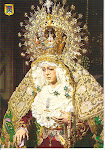 History
History The statue was brought to Manila by the first group of Augustinian Recollect friars on May 31, 1606.The image was originally housed in the first Recollect church in Bagumbayan (now part of the Rizal Park), which was inaugurated on September 10, 1606, and placed under the patronage of Saint John the Baptist.
In 1608, the image of the "Nazareno" was transferred to the second, bigger Recollect church dedicated to San Nicolas de Tolentino (Saint Nicholas of Tolentino) The Recollect Fathers vigorously promoted devotion to the Suffering of Our Lord represented by the image that in fifteen short years, the Cofradia de Jesús Nazareno was established on April 21, 1621. The confraternity obtained Papal approval on April 20, 1650, from Pope Innocent X.
Sometime in the year 1787, then Archbishop of Manila, Basilio Sancho de Santas Junta y Rufina, ordered the transfer of the image of the Nazareno to the church in Quiapo, again providently placed under the patronage of Saint John the Baptist.
The image survived the great fires that destroyed Quiapo Church in 1791 and 1929, the great earthquakes of 1645 and 1863, and the destructive bombing of Manila in 1945 during World War II.
Recently, however, in 1998, a replica of the original Black Nazarene was first paraded due to the repeated damages inflicted on the statue. Today this replica is still used in the processions while the original rests inside the church, and other, even smaller replicas can be found in other churches.
Devotion
The devotion to the miraculous Nuestro Padre Jesús Nazareno has attracted huge following among the populace. Its popularity, which initially spread to the northern and southern provinces of Luzon, spread over time throughout the country.
The uniquely Filipino devotion to the Black Nazarene merited the sanction and encouragement of two popes: Innocent X in 1650, with a Papal Bull canonically establishing the Cofradia de Jesús Nazareno, and Pius VII in the 19th century, by granting indulgence to those who piously pray before the image of the Black Nazarene of Quiapo.
Processions
Today, despite the rough-and-tumble that usually accompanies the thrice-yearly procession of the image, the Filipino people's devotion to God in the special appellation of Nuestro Padre Jesús Nazareno continues to flourish and shows no sign of waning; death, wounds, bodily pains and physical discomfort notwithstanding.
For more than 200 years, the statue has been placed on a gilded carriage every January 9th and pulled through the streets of Quiapo by male devotees clad in maroon. People who have touched the Nazarene are reported to have sometimes been healed of their diseases. Catholics come from all over Manila for the chance that they will be able to get close enough to touch the image and perhaps even receive a miracle. They also throw towels or handkerchiefs to the people guarding the statue and ask them to rub them on the statue in hopes of carrying some of that power away with them.
The procession, and the accompanying Feast of the Black Nazarene, takes place every year on January 9. This commemorates the Translacion or the transfer of the image to its present shrine in Quiapo[citation needed]
Events in the 2008 feast
On January 9, 2008, the number of devotees who joined the procession swelled to 80,000 in Quiapo, Manila. One-and-a-half to three million people can be accommodated around Plaza Miranda and Quezon Boulevard. Two people died and around 50 injured devotees were rushed to 2 hospitals and a makeshift clinic of the Philippine National Red Cross for first aid treatment, as the procession proceeded.Vice President Noli de Castro, a known devotee of the statue, also joined the big procession. MPD District Director Senior Supt. Roberto Rosales stated that the crowd swelled to 2.2 to 2.6 million "when others, including local residents, joined the procession along the 4.7-km route.” The procession ended at 9:45 p.m. In 2006, 2 devotees also died and 20 others only were injured during the procession.
Wikipedia











No comments:
Post a Comment